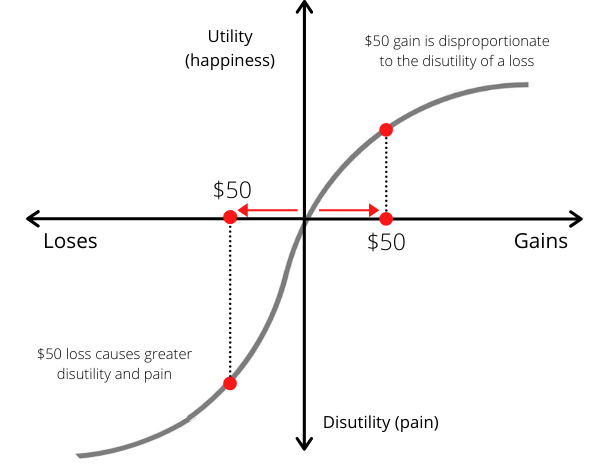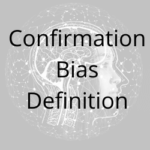Prospect Theory: Definition & Examples
What is Prospect Theory
Prospect theory was originally developed by Daniel Kahneman and Amos Tversky in 1979. The theory is based upon the idea that we value losses and gains differently. More specifically, it states that individuals would rather avoid losses than similar gains – because losses create a stronger emotional effect than gains.
Prospect theory shows how people react differently based on risk and uncertainty. For example, imagine gaining $1,000, then losing that same $1,000. Which causes a greater emotional reaction? That’s part of the premise of prospect theory. We tend to place a greater value on avoiding losses due to the associated negative emotional impact.
Key Points
- When faced with a potential gain, individuals are risk-adverse. However, when faced with a potential loss, individuals become risk-seeking.
- Prospect theory says that people will value certainty over risk, especially when gains and losses are equal in likelihood.
- The isolation effect in prospect theory occurs when people focus on differences between options rather than similarities. This can cause people to miss out important factors in decision making.
- Prospect theory states that an individual’s fear of losses is greater than their joy of gains
In short, prospect theory assumes that the individual is loss-adverse when faced with a potential gain. In general, they would prefer to avoid the risk of a loss than risk it for an equal gain.
However, when the individual is faced with a loss, they tend to become risk-seeking in order to avoid the loss. For instance, a gambler that is down $500 is more likely to take a risk to gain $500 than if they were up $100.
Prospect Theory Explained
If we look at the graph below, we will see prospect theory illustrated. As we can see, the utility received from a gain is disproportionate to the disutility we receive from a loss. In other words, losses impact on our happiness far more than an equal gain. Therefore, we tend to value losses and gains in different ways.

An important part of prospect theory is that individuals tend favour options that offer a perceived gain, even if the outcome is the same. In other words, they favour one option because it is framed in a way to make it seem like it is a net gain.
For example, there are two options. Option 1 gives the recipient $50. Option 2 gives the recipient $100 but then takes away $50. The end outcome is that both provide a net gain of $50. Yet option 1 is preferred as it provides the recipient with a perceived net gain that avoids the pain of a loss.
This moves us onto the 3 main factors that influence decision making in prospect theory. They are; certainty, isolation effect, and loss aversion.
Let’s look at them below.
1. Certainty
In prospect theory, there are two types of certainty. The first is the certainty of gain, and the second is the certainty of loss.
The theory dictates that when faced with a potential gain, people will generally choose a certain gain over a risk that rewards an even greater gain. This is also referred to as ‘risk-averse’. However, the opposite is true with losses.
When faced with the certainty of losses, the theory concludes that people take greater risks in order to avoid the certainty of a loss. Just imagine the typical gambler trying to recover all of their losses and becoming increasingly desperate whilst doing so.
Certainty of gains
With regards to the certainty of gains, consider two options. In the first scenario, you can take $50. In the second scenario, you can flip a coin for $100, or you win nothing.
Under such a scenario, there are ‘certainty’ biases as the vast majority opt for the guaranteed option. This is because uncertainty is a significant factor in the cause of stress. So people tend to have a bias that tries to prevent them from such pain.
Certainty of loses
We then have the certainty of losses. People start to take greater risks to avoid the certainty of a loss.
Consider two options. In the first scenario, you are guaranteed to lose $50. In the second scenario, you can flip a coin, lose nothing, or lose another $50.
What prospect theory dictates is that people, in general, will choose the second option in order to avoid losses and the pain associated with such. In other words, people have a sharper emotional reaction to loss than gain.
2. Isolation Effect
In prospect theory, the isolation effect occurs when people focus on differences between options rather than similarities. This is to reduce the cognitive strain placed on our brains and simplify the decision-making process.
This is otherwise known as the Von Restorff effect, named after German psychiatrist and pediatrician Hedwig von Restorff, who coined the theory.
In her study, she founded that when a stimulus was different, it was more likely to be remembered. For example, a highlighted bit of text is more likely to be remembered than the other bits because it differentiates from the rest.
If we look at the picture below, we are more likely to remember the yellow pepper as it is visibly different. This is important with regards to purchasing decisions as marketers often aim to ‘stand-out’ on the shelf in order to gain favour among customers. Products that look similar are seen as similar in the consumer’s eye, even though they may taste completely different.

The isolation effect is important because it impacts on our everyday behaviour. We not only remember the differences between two stimuli, but we also tend to give it greater weighting.
3. Loss Aversion
In prospect theory, loss aversion is where an individual’s fear of losses is greater than their joy of gains. In other words, people prefer to minimise losses than maximise gains.
The reason for this is that people tend to remember losses more profoundly than gains. It’s a type of survival mechanism that aims to prevent us from getting hurt as each loss presents varying degrees of psychological pain.
When faced with a choice that presents an equal gain or loss, people tend to place greater weighting on the loss. So, when the two outcomes are equal, we tend to reject the option as the losses are seen to have a greater likelihood.
Tversky and Kahneman found that there are varying degrees by which this occurs between individuals, but the theory remains relatively consistent throughout.
When the odds of an equal gain or loss are equal, the majority of people are likely to reject the option. However, when the odds start to favour gains more, we start to split down into greater sub-sections. For instance, a 60 percent of a gain and 40 percent of a loss is enough for some to take the jump. Yet for others, it may need to go up to 90 percent.
Nevertheless, the conclusion is that people tend to value losses more so than gain, so put a greater emphasis on such. However, that emphasis varies from individual to individual.
Prospect Theory Example
A study in 1995 by the American Psychological Association looked at the 1992 Barcelona Olympics. More precisely, it looked at the psychological impacts between finishing in silver and bronze place.
The study compiled video footage of the medal ceremony as well as the moments after the positions were announced. So imagine the reaction of a 100m runner just finding they won by 0.1 of a second.
The video footage was then shown to a group of undergraduate students who were asked to rank the happiness display on a scale of 1 to 10. 1 signified agony, whilst 10 was complete ecstasy.
The study found that bronze medalists were significantly happier following the results than those who won a silver medal. Bronze medalists scored 7.1, whilst silver medalists scored 4.8.
Even after the announcement, bronze medalists were much happier at the ceremony, ranking 5.7. Still higher than silver medalists who scored 4.3.
So why were bronze medalists happier? Well, the answer is explained by counterfactual thinking. Simply put, the silver medalist was expecting and aiming for gold, so was therefore disappointed to not have met that aim. However, the bronze medalist expects to finish around 4th or 5th, so a bronze medal exceeded expectations.
FAQs on Prospect Theory
Prospect is the odds or chance or some future outcome occurring. Prospect theory covers the thought process that occurs when humans anticipate a future outcome. People are more likely to pick certainty over uncertain outcomes. For instance, there are two options. Option 1 guarantees $50. Option 2 has a 50-50 chance of winning $100 or potentially winning nothing. Most people will choose option 1, as they prefer certainty as found in prospect theory.
Prospect theory was developed by Daniel Kahneman and Amos Tversky in 1979, with the former winning the Nobel Prize for the research in 2002.
Prospect theory is important because it helps us understand the decision making process. It can help us understand why gamblers often scramble desperately to regain their winnings and it can help policy makers make effective decisions.
About Paul
Paul Boyce is an economics editor with over 10 years experience in the industry. Currently working as a consultant within the financial services sector, Paul is the CEO and chief editor of BoyceWire. He has written publications for FEE, the Mises Institute, and many others.

Further Reading
 Confirmation Bias: Definition & Examples - Confirmation bias occurs when people deliberately exclude or place less weight on new evidence which contradicts existing beliefs.
Confirmation Bias: Definition & Examples - Confirmation bias occurs when people deliberately exclude or place less weight on new evidence which contradicts existing beliefs.  Availability Heuristic: Definition & Examples - The availability heuristic is where recent memories are weighted more significantly.
Availability Heuristic: Definition & Examples - The availability heuristic is where recent memories are weighted more significantly.  Checks and Balances - Checks and balances is a system that prevents the concentration of power by distributing and restraining the authority among different…
Checks and Balances - Checks and balances is a system that prevents the concentration of power by distributing and restraining the authority among different… 